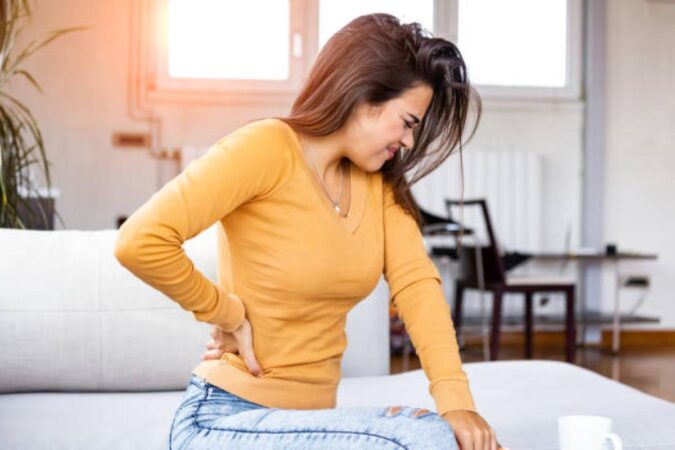Sometimes, it doesn’t have to be the immediate source of the pain, even when it comes to lower back pain. Instead, many healthcare professionals believe it’s better to work on improving a person’s overall health and well-being. A holistic method of treating lower back pain can help people recover naturally and avoid drastic measures like invasive surgery.
Medications are often prescribed to treat l4-l5 spinal stenosis or spondylolisthesis in the lower back. Still, medications like non-steroidal anti-inflammatory drugs have potential side effects that can impact a patient’s daily life. That’s why doctors prefer to focus on lifestyle changes and organic treatments for spinal conditions and related pain.
What can cause lower back pain?
Lower back pain can occur at any stage of a person’s life, possibly due to an injury, such as one sustained in a car accident or a sports collision. However, lower back pain is more common in people over 50 due to dress and tear on the various elements that make up the spine. These elements are the vertebrae, the discs inside the spine, the ligaments, and the tendons. These elements can pressure the nerves and spinal cord when damaged, causing pain and other indications.
Common conditions that cause low back pain include herniated discs, degenerative disc disease, spinal stenosis, spondylolisthesis, and sciatica.
- A herniated disc happens when the soft, cushion-like tissue inside the disc breaks away from its outer covering and impinges on the nerves.
- Degenerative disc disease is when the discs lose moisture over time and no longer provide the cushioning the vertebrae need.
- Spinal stenosis is when the spinal canal tapers, causing compression.
- Spondylolisthesis is when one or more vertebrae slip forward and press on the spinal cord or nerves. The slippage can vary greatly, with some experiencing no pain or discomfort.
- Sciatica is a density of the sciatic nerve that can cause pain, numbness, weakness in the legs, and lower back pain.
6 Holistic Approaches For Managing Lower Back Pain

Holistic approaches to treating lower back pain can range from herbal remedies to professional treatments. We outline the top 7 holistic strategies for managing back pain and improving overall physical well-being.
1. Massage Therapy
Many people who suffer from back pain can benefit from massage therapy, a service that a licensed physical therapist or massage therapist can often provide. This holistic approach can even help manage chronic pain and may be more cost-effective than medications and regular physical therapy visits.
Massage targets the inflamed area to relieve tension and improve circulation directly, reduces anxiety, makes a person more relaxed, and can help people overcome depression. Getting a massage once a week can provide short-term pain relief and positively affect the mind.
2. Supplements
Many helpful supplements can have a direct effect on lower back pain. For example, capsaicin cream can be applied to painful areas and acts as an analgesic by reducing the neurochemicals that cause discomfort.
Vitamins such as D and B12 are also recommended for people with spinal conditions. Vitamin D has been exposed to affect muscle pain. Additional vitamin D can be obtained by eating more fish and dairy products or taking concentrated tablets. Meanwhile, B12 can reduce pain and improve mobility when injected directly into the back.
Magnesium is essential to the human body, regulating the immune system and supporting critical biochemical reactions. It is vital to supporting nerves and muscles, so anyone with back pain should consider taking magnesium supplements to increase the amount in the body.
Finally, many natural anti-inflammatory herbs exist, such as turmeric, devil’s claw, or white willow bark. White willow bark covers salicin, which is a potent anti-inflammatory.
3. Acupuncture
Acupuncture, a traditional Chinese medical practice, is designed to release trapped energy in the body by identifying pressure points and inserting tiny, thin needles. Scientifically, this method effectively releases natural hormones, neurochemicals, and opioids that relax a person and relieve pain. Visiting an acupuncturist at least once a week can make a significant difference in treating lower back pain.
4. Chiropractic Treatment
You may consider seeing a best chiropractor who can perform spinal manipulation to improve joint health and mobility. Chiropractors manually massage the body to loosen stiff or damaged joints, reducing pain and inflammation.
5. Posture/ The Alexander Technique
The Alexander Technique improves posture and mobility by teaching people to avoid bending, keep their muscles relaxed, and constantly support the spine. A professional usually teaches this technique in a private setting. Essentially, this method makes people aware of their bad posture habits and teaches them to maintain good posture subconsciously.
6. Yoga
Yoga has its roots in antique India and focuses on a set of poses and postures that, when practised regularly, make the body more robust and more flexible. Each pose targets a different body aspect, with many poses focusing on building strength in the spine and core muscles. This will assist in supporting the spine better and reduce the likelihood of back pain.
Each method has its benefits, but it is essential to remember that each person is different, and what works for one person may not. However, even if holistic approaches do not affect back pain noticeably, they still provide general benefits that may reduce the likelihood of developing other conditions and diseases later.

